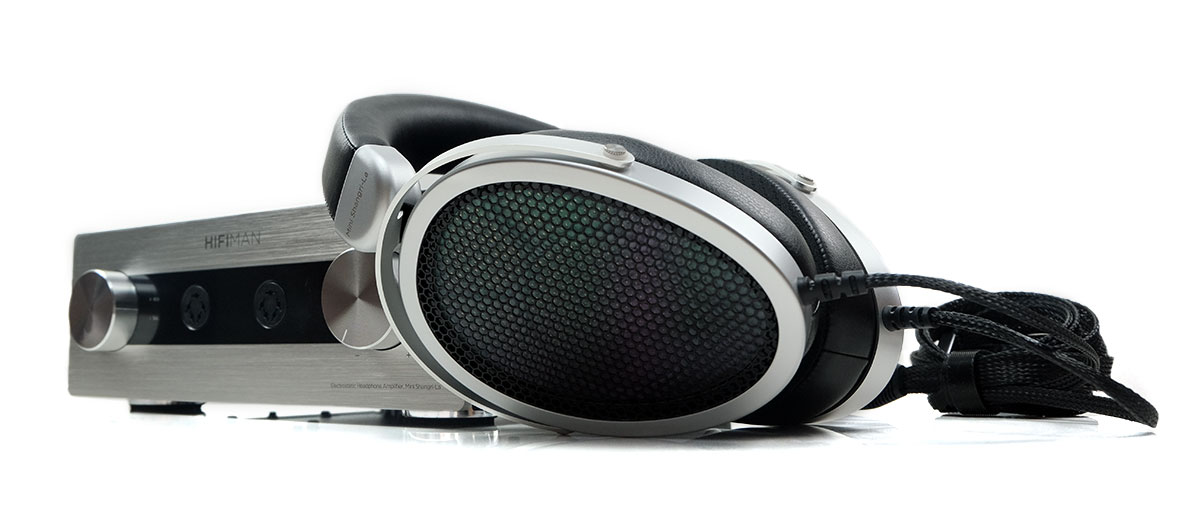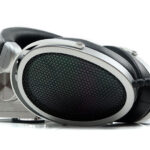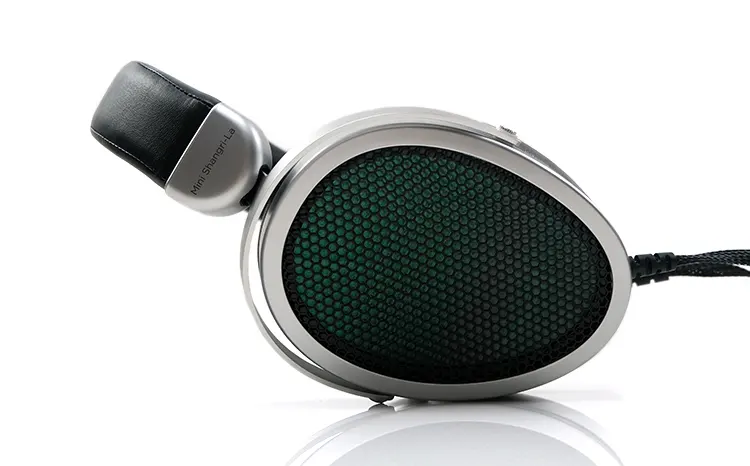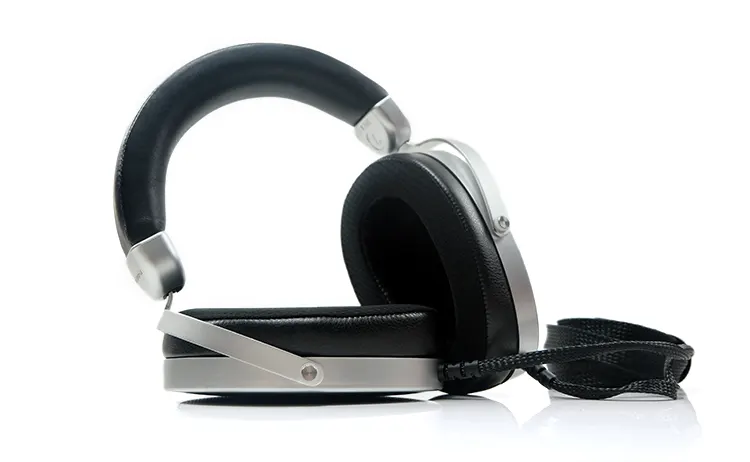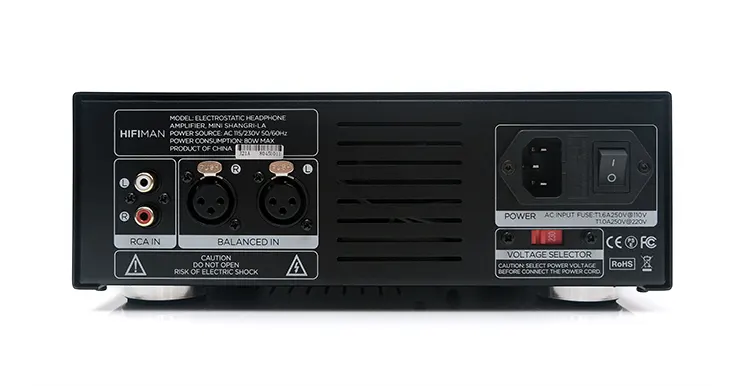In this feature, Marcus reviews the HIFIMAN Mini Shangri-La, which is a new electrostatic headphone and pro-bias amplifier system priced at $2300.
Disclaimer: This sample was sent to me in exchange for my honest opinion. Headfonics is an independent website with no affiliate links or status. I thank the team at HIFIMAN for their support.
To read more about the HIFIMAN products we have previously reviewed on Headfonics click here.
Note, that this post follows our current scoring guidelines which you can read in more detail here.
The HIFIMAN Mini Shangri-La is the company’s fifth electrostatic headphone offering, if we include the original Jade headphones launched in 2008.
Consistent with the last three electrostatic headphones launched, the Shangri-La, the Shangri-La Jr, and the Jade II, this is being primarily marketed as a system, i.e. an energizer and a set of headphones priced at $2300 for the bundle. However, you can buy them separately at $1100 for the headphones and $1500 for the amplifier.
That price positions the Mini Shangri-La above the older Jade II which drops from $2499 for the bundle in 2019 down to $1700. At the time of writing, the Jade II is still available which might confuse potential buyers as to which is the best option for them
I will go into more detail on how both compare on page 3 of this review. The TLDR is the new Mini Shangri-La delivers a very different experience from the Jade II with a smoother, more mid-forward sound signature.
It has a few design quirks, (mainly the headphones) but otherwise represents a solid and capable electrostatic system for those looking for a medium path between starter kits like the Koss ES950 and higher-end models like the Shangri-La Jnr.
Features
The HIFIMAN Mini Shangri-La is a set of open-back electrostatic headphones combined with a dual 5-pin 550-650v (Pro-bias) energizer (amplifier).
Headphones
The Mini Shangri-La headphones seem to pull heavily from the Jade II design. You get a similar 90mm <0.001mm nanometer-thickness diaphragm and a nanoparticle coating at a sub-micrometer thickness to improve the stability and accuracy of the driver’s conductivity.
The new headphones are also designed with a nanometer-thick acoustically transparent protection layer. This is a feature that HIFIMAN previously referred to as a dust cover.
Given the smoother tone, I wonder if the diaphragm tension on the Mini Shangri-La headphones is slightly looser compared to the Jade II driver design.
Amplifier
The energizer (amplifier) is a pro-bias (550V – 650) transistor high voltage direct output solid-state topology equipped with a claimed discreet fully balanced preamplifier and power supply.
It also uses a linear transformer positioned on the left side of the chassis. However, despite being fairly heavy at nearly 6 kg the transformer does not skew the unit’s weight balance.
Because of the pro-bias ratings, you are not hog-tied to using the Mini Shangri-La headphones only. HIFIMAN has equipped the amplifier with dual 5-pin outputs meaning you can run two electrostatic headphones from the amplifier at the same time.
Headphones
There are pros and cons with the new Mini Shangri-La headphone design, at least when compared to the Jade II version.
The positive is that it is quite light at 320g or just over 40g lighter than the older Jade II design. With its large ovoid cup and earpad opening, I found them to be very comfortable to wear.
The ear pads have a similar hybrid construction to the Jade II version. However, they offer a wider contact surface and more discreet seamlines on the edging that is less likely to touch your ears when in use.
The inner wall of the new pads is also slightly deeper with some enhanced perforation compared to the shallower Jade II pads. It’s tough to tell after 4 years of use but arguably, the fabric materials on the Mini Shangri-La pads are better quality than the older Jade II pads.
The retention of the iridescent driver color scheme that changes from the green of the original Jade to a slightly red hue depending on the angle of the cup is still a very cool touch.
The drawback is the material and frame choice lifted from their latest generation of mid-priced planars such as the Edition XS. It is functionally good but presents the wrong optics for me considering these headphones are around 3 times more expensive than the Edition XS.
I will say though that the stifling rigidity of the Jade II’s older generation frame used with the Sundara and the Ananda is a thing of the past.
The Mini Shangri-La frame has a superior level of lateral articulation accommodating more head sizes and with fewer disconcerting creaking noises from its aluminum yoke than the Jade II’s fixed-frame version which is a plus.
Stock Cable
The Mini Shangri-La headphones use the same cable that comes with the Shangri-La Jr and the Jade II which is not exactly blowing the house down in terms of aesthetics or build quality.
If you are looking for positives in the cable design it is lighter and thinner than the Stax and DCA variants so the handling is much easier. I have used both of the previous headphones with this cable without issue for a few years now, and none of them have developed wiring problems.
However, I have been fairly observant when handling the cables, more so than the more durable Stax SR-L300 Limited or Dan Clark Audio CORINA cables.
The cable is terminated with a pro-bias 5-pin and I have no issues with the durability of the plug. To be fair, the stock cable has some excellent strain relief at all connection points.
Amplifier
Design
I love the look and feel of the Mini Shangri-la amplifier. Its design language is more classic HiFi, with its two-tone brushed silver aluminum and black panel outer finish, which takes its cue from the more compact EF400 solid-state resistor amp.
I don’t have the EF400 here for a nuanced comparison but the Mini Shangri-La amp is much bigger on paper and twice the weight at just under 6 Kg. Its quad column and rubber feet base do an excellent job of keeping that weight firmly in place on smooth surfaces.
Its uniform rectangular shape makes it very stackable but I would stack it on top of the amp rather than place it on top of another amp unless the other amp is a huge unit such as the Gustard H26.
The front panel is adorned with two sizeable dials, one is a rotating function selector that replaces the Jade II’s wobbly button for selecting the amplifier’s balanced XLR or single-ended RCA input.
The other is a similar 21-step attenuator which feels substantially more accurate with better resistance and tighter clicks than the one used inside the Jade II amplifier.
I/O
The rear panel of the Mini Shangri-La amplifier is very clean and similar to how you would expect everything to line up on a Stax amplifier with the inputs housed on the left side and the power and voltage selector switch on the right. You get balanced and single-ended options with dual 3-pin XLR and dual RCA.
Like the Jade II and Shangri-La Jr. amplifiers, the Mini Shangri-La amplifier has a dual 5-pin pro bias output, meaning you can run two electrostatic headphones off the amplifier at the same time. This makes my job of reviewing a whole lot easier.
One important note is the 110v-230v voltage selector on the rear panel. It is user-controlled and ideally should be set to your regional power requirements by default. However, I always advise checking this before powering up the amplifier to avoid damaging the circuit inside.
Packaging & Accessories
The Mini Shangri-La System comes in a fairly non-descript single large courier box housing two smaller boxes, one for the headphones and one for the amplifier. If you order them separately I presume the courier packaging is smaller.
Both the headphones and amplifier boxes are the newer HIFIMAN brown box types, with a single informative product label on one side.
Though amply protected with black foam for both units you will not get any fancy display boxes with the headphones. Rather it’s functional over aesthetics but does what it is intended to do.
The Mini Shangri-La amplifier is wrapped in a light protective cloth to protect from the elements and comes with a power cable in a separate box on the top foam layer.
There is nothing else accessory-wise such as a set of interconnects though HIFIMAN is offering a free headphone stand from the Shangri-La Jr until stocks last (?) for initial orders during its launch month.




